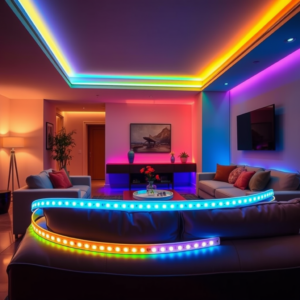Can LED light strips cause a fire? In 2021, a nightmare unfolded for a family in Penn Township when an LED light strip malfunctioned and started a fire in the dead of the night. Fortunately, the family of four and its pets managed to escape without injuries, cautioned on the importance of safety concerning electrical devices. While LEDs are generally much safer than older types of lights. Yet using bad lights or poor installation could compromise that safety. Knowing these dangers and avoiding hazards is vital when selling a fire-damaged house. Knowledge equips homeowners to reap the benefits of LED without fear.
Are LED Light Strips a Fire Hazard?
LED strip lights are not highly prone to combustion. They consume less power and generate less heat than incandescent or halogen lamps, and they do not use filaments that might otherwise get HOT. Under improper installation, mishandling, or in faulty electrical systems, the risk of fire rises.
Key reasons why LED light strips might ignite include the following:
- Cheap Manufacturing
Low-end LED strips mostly made by unrecognized manufacturers use low-grade materials like poor wiring insulation or weak soldering. These materials can become hot, posing the risk of burning down. - Improper Installation
LED strip installation in proximity to heat-sensitive furnishings or flammable materials like curtains, papers, and untreated wood can raise the fire risk should the strips overheat. - Overloading Circuits
Improper power sources or by overloading electrical circuits with many LED strips could result in danger through sparking or short-circuit thereby causing a fire hazard. - Neglecting Safety Guidelines
If the user fails to observe the safety instructions provided by the manufacturer, including the proper use of compatible power adapters or electrical connections, they risk even further chances of malfunction.
Although LED light strips themselves don’t burn easily, external factors—like electrical issues or flammable surroundings—play a significant role in causing potential fires.

How to Minimize Fire Risk with LED Lights
Reducing the chances of an LED-related disaster boils down to proper usage, maintenance, and purchasing high-quality products. Here are some effective ways to stay safe when using LED lighting in your home.
1. Only Buy Certified Products
Choose LED strips that comply with safety standards like the UL (Underwriters Laboratories) certifications. Certified products by know manufacturers give assurance that they have been tested for quality and efficiency, limiting the chances of overheating or failure.
2. Install Strips Correctly
Install LED Strips on materials that are fireproof and avoid contact with any combustible materials. Also, check if there is a proper airflow in the installation area, as overheating will be avoided if it is able to dissipate heat effectively.
3. Use a Compatible Power Adapter
Pair your LED strips with their matching power adapter that has the same voltage and wattage requirements for the lights; otherwise, using another type of adapter could cause power surges which may lead to electrical fires.
4. Inspect Wiring Regularly
Verify whether there are frayed wires, loose connections, or signs of wear and tear on any LED strips or components. Any damaged part should be fixed or replaced immediately to avoid electrical failures.
5. Avoid Overloading Outlets
Plugging multiple LED strips into a single circuit might save you extension cords, but it could strain your home’s wiring. Spread the load across multiple outlets or use power surge protectors designed for heavier loads.
By following these simple steps, you can rest assured that your LED lighting setup will remain both beautiful and safe.
Exploring the Connection Between LED Fire Hazards and Selling Fire-Damaged Homes
Damages due to fire caused by LED lighting strips—or by anything else, for that matter—can be termed minor or major. For safety-conscious individuals, the question often isn’t just “can LED light strips cause a fire?” but also how to prevent such risks in the first place. Fire not only jeopardizes lives but also leaves a lasting mark on property value and marketability. The process of recovery and preparing the house for sale after fire damage will require added planning and honesty.
The Impact of Fires on Property Value
Fire causes smoke damage, odor, and destructive structural damage, which may be expensive to repair. For example, a small fire from wiring for an LED could result in some scorched walls and roof. The full repair of the room may then become necessary. Prospective buyers often see fire-damaged homes as risky investments and expect either thorough repairs or a significant price reduction.
While LED light strips are widely regarded as safe, you should always take precautions. Asking yourself, can LED light strips cause a fire? highlights the importance of using quality products, following installation guidelines, and inspecting them regularly. Fires often occur when we least expect them, but proper preparation can prevent tragedy and protect your property.
Previous